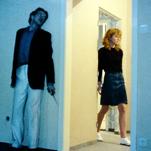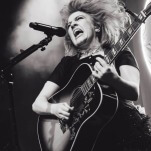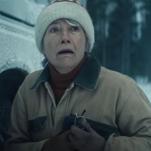Raw, Naked Rancor: On Feud, Big Little Lies, and the Complicit Audience
Byron Cohen/FX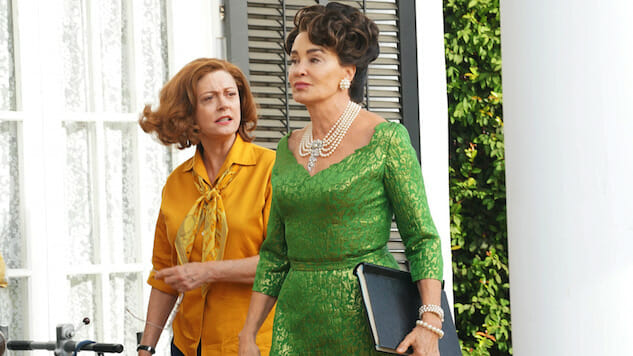
It’s the sort of showy, self-assured gesture that one often finds in Ryan Murphy’s direction—from the brilliant (The People v. O.J. Simpson’s “Marcia Marcia Marcia”) to the baffling (the decision to conclude The Normal Heart with “The Only Living Boy in New York”)—but the first time I saw the long, hectic climax of “And the Winner Is… (The Oscars of 1963),” I straightened in my seat. You know the one I’m talking about: Feud’s fifth episode culminates in Joan Crawford’s (Jessica Lange) circumnavigation of the theater’s bowels, depositing David Lean (Best Director, Lawrence of Arabia) with victors and well-wishers before circling back to the stage. If the passage through corridors and dressing rooms creates the sequence’s tension, though, it’s another pair of images that set it alight. As the famous phrase leaves Max Schell’s lips, the camera sweeps toward the two combatants in Murphy’s feud, reprising the expectant style that met their earlier confrontation—as if the director, and his audience, were spoiling for a fight.
Despite the relative dearth of fireworks in FX’s dual portrait of Bette and Joan—its affect is closer to American Crime Story than American Horror Story—Feud became an object of contention among critics, inviting multiple, at times oppositional, readings. The series’ slipperiness was, in fact, at the heart of my own first impression: I felt as though I could write two distinct reviews of Feud, each one of equal conviction. On one hand, it’s a stiff gin Gibson of glamour without the requisite key of camp cocaine, a travesty of good taste; on the other, it’s an ingenious deconstruction of Hollywood myth, rendering the viewer unnervingly complicit in the desire for what gossip columnist Hedda Hopper (Judy Davis) describes as “raw, naked rancor.”
By the time Feud reaches its stirring conclusion, returning to the Oscars 15 years later, the former seems uncharitable, the latter apt: Though Murphy at times telegraphs his purpose to the point of stiltedness, his resuscitation of Crawford and Davis mostly succeeds. “Fifty years in show business and they give her two seconds,” one of Davis’ companions remarks, referring to the late Crawford’s brief appearance in that year’s “In Memoriam” montage. “That’s all any of us will get,” Davis replies. There’s a certain self-congratulation in Feud—Murphy patting himself on the back for keeping aging actresses in high cotton by depicting two legends who were discarded too soon—but the series’ acknowledgement of the culture’s merciless treatment of women, its unquenchable thirst for the next “it” girl or bright young thing, turns out to be more compelling than any petty insult or pitched battle. In part, I’d argue, because it draws the viewer into its critique: In the hooting and hollering of fans smitten with What Ever Happened to Baby Jane? and its “hagsploitation” imitators, as in the schemes that Hopper, filmmaker Robert Aldrich (Alfred Molina), and studio chief Jack Warner (Stanley Tucci) devise to stir up trouble between the two stars, I saw my initial yearning for more bitchiness, more friction, more fun. When Hopper says in the opening stages of “And the Winner Is…” that “Hypocrisy is the tribute vice must pay to virtue”—framed, as if to underscore her meaning, in a nest of perfect symmetries (two chairs, two side tables, two lamps, two sets of doors)—it rings as a rebuke, or perhaps a warning. You want rancor? Murphy asks. I’ll give you rancor.
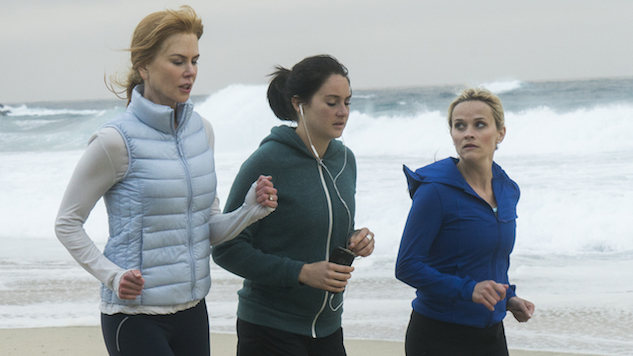
The insight of Feud’s second half, which frames this eagerness for behind-the-scenes spite as an accelerant in Crawford and Davis’ respective declines, is to understand that what we want and what we say we want when it comes to entertainment are often at loggerheads: Like Hopper, or the “witnesses” to the homicide at the center of HBO’s Big Little Lies, we expect virtue, but enjoy vice. As with Feud’s structuring conceit, the making of a documentary about Crawford and Davis’ difficult relationship, Big Little Lies’ reliance on a series of retrospective interrogations to comment on the action—a Greek chorus of catty neighbors—is rather clumsily handled, adding nothing more than a few choice one-liners to the series’ superb portrait of discontent in an affluent village. But the sniping at Madeline (Reese Witherspoon), Celeste (Nicole Kidman), Jane (Shailene Woodley) and Renata (Laura Dern)—their careers, their marriages, their children, the very fabric of their character—highlights the ease with which other people’s problems, real or imagined, become grist for the gossip mill. In Big Little Lies, created by David E. Kelley from Liane Moriarty’s novel and directed by Jean-Marc Vallée, even the tiniest Monterey hamlet is full of Hedda Hoppers, moralists rooting for rancor as they pretend to want peace.
That two of the year’s most widely discussed series deal explicitly with the consequences of pitting women against each other—and a third, Hulu’s The Handmaid’s Tale, transforms “divide and conquer” into the foremost mechanism of a misogynist regime—emphasizes the intractable nature of sexism at a moment in which it’s become rightly laughable to pose the old question, Can women have it all? “Leaning in” doesn’t prevent Renata Klein from feeling helpless to protect her daughter, or save the intrepid Joan Crawford from being cast aside; “leaning out” doesn’t spare Celeste from her abusive husband, Perry (Alexander Skarsgård), or Jane from her traumatic past. Without sanding their characters down to perfection, without refusing to allow them the relief of their flaws, Feud and Big Little Lies are both at pains to see the characters’ sparring as a function of the social order, in which the demands we place on women far outstrip those we place on men. “I spent my whole life being Joan Crawford, a woman I created for others,” Crawford says at a ghostly card party in Feud’s finale, a figment of her imagination that nonetheless punctuates the series’ main thrust. “I don’t know who I am when I’m by myself.”
The “others,” of course, are you and I, as insistent and impatient as the audiences for Straitjacket or the parents in the carpool line, salivating at the prospect of conflict and then tsk-tsk-ing when women deliver what we asked for. We prize beauty, then criticize those who pursue plastic surgery; we lionize chastity, then call the adherents “prudes” and the violators “whores.” Whether in Washington or Hollywood, at home or on screen, our culture betrays its patriarchal nature with such abandon that even the well-meaning question is already loaded: We never ask if men can “have it all,” because men possess the power, the privilege, of being imperfect.
Though the latter is the more consistent, and compelling, of the two, Feud and Big Little Lies both emerge, in the final estimation, not as attempts to guilt us into assent, but to use our interest in “raw, naked rancor” to their own ends—and both conclude, tellingly, with images of camaraderie, even solidarity, that satisfy our appetite for entertainment because they’re hard earned. We, the audience, the culture, may be complicit in the indignities visited upon women, past, present, and (dystopian) future, but by the time we reach that sun-splashed beach on the California coast, or that moment of friendship on set, Feud and Big Little Lies have proven that it’s possible to carve another path. It’s notable, in this vein, that the only interrogations we don’t hear in Big Little Lies are those of the main players, five women, including Zoë Kravitz’s Bonnie Carlson, who forge a common front against a man’s abuse. When we’re listening to the squabbling, or spoiling for a fight, the two series suggest, we stand to miss out on the real story, the one we didn’t know we wanted in the first place.
Matt Brennan is the TV editor of Paste Magazine. He tweets about what he’s watching @thefilmgoer.



